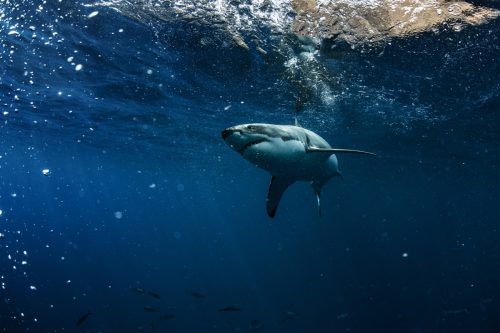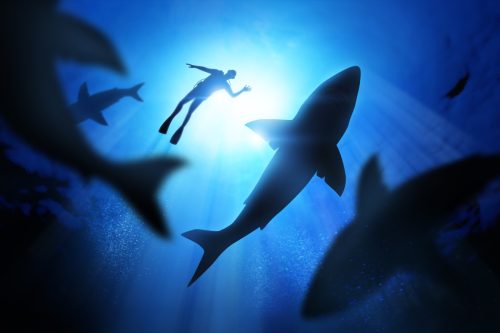Video Captures Moment When Giant 7-Foot Shark Swims Up to Clueless Swimmers
"It was unnerving at moments to watch."

Just when you thought it was safe to go back in the water … well, is its safe to go back in the water? Shark sightings are up along beaches this summer, but perhaps none so dramatic as one captured on video at Daytona Beach. There, a drone recorded a seven-foot-long shark coming within feet of two swimmers. Read on to find out what happened, how likely shark attacks are, and how you can avoid encountering a shark when you're at the beach.

Drone pilot Robert Russ captured the seven-foot-long shark swimming at Daytona Beach, which is northeast of Orlando. The creature, possibly a Blacktip shark, swam from the boardwalk, at one point coming precariously close to two swimmers. They waved to the drone but seemed completely unaware of the shark nearby, and Russ was too far away to warn them.
Russ continued to follow the shark, which provided a few anxious moments. "It swam towards multiple people before realizing they were not food and moving on," Russ told Fox 35. "It was unnerving at moments to watch this since there are quite a few people bitten here, but confirms they are generally unintentional bites."

Sharks generally aren't aggressive toward people. "Most sharks are not dangerous to humans, says the National Ocean Service. "People are not part of their natural diet." However, sharks may attack when they are confused or curious. "If a shark sees a human splashing in the water, it may try to investigate, leading to an accidental attack."

Volusia County, home to Daytona Beach, is known as "the shark bite capital of the world." There have been six shark attacks there in 2022—and three in the last month. Shark attacks have also been on the rise at New York City beaches this summer. There have been six shark attacks off the coast of Long Island, although no one has been seriously injured.

The increase may be due to increasing ocean temperatures. "There is an effect with sharks and climate change, but it's not a numbers thing. It doesn't mean more sharks; it means different sharks," New York-based shark expert Christopher Paparo told Curbed. "We're seeing spinner sharks and blacktip sharks more frequently in our waters. And as the ocean warms, some of our local species aren't happy, and they're going to shift north."

Even with the upswing in shark sightings, your odds of being attacked by a shark are exceedingly rare. A person's chance of dying from a shark attack is one in 4.3 million, while the chance of dying in a car accident is 1 in 84.
To avoid encountering a shark, Paparo advised not swimming at dawn and dusk, when sharks tend to feed; don't swim in a school of bunker; don't swim when the water is murky; and swim only where there's a lifeguard.














